05.05.05 Jn. 3:1-21 Jerusalem: Jesus met an Inquiring Rabbi
NICODEMUS AND HIS NEW BIRTH
1 There was a man from the Pharisees named Nicodemus, a ruler of the Jews. 2 This man came to Him at night and said, “Rabbi, we know that You have come from God as a teacher, for no one could perform these signs You do unless God were with him.”
3 Jesus replied, “I assure you: Unless someone is born again, he cannot see the kingdom of God.”
4 “But how can anyone be born when he is old?” Nicodemus asked Him. “Can he enter his mother’s womb a second time and be born?”
5 Jesus answered, “I assure you: A Unless someone is born of water B and the Spirit, C he cannot enter the kingdom of God.
A’ 6 Whatever is born of the flesh is flesh, and B’ whatever is born of the Spirit is spirit. C’ 7 Do not be amazed that I told you that you must be born again
A 8 The wind blows where it pleases,
B and you hear its sound,
B’ but you don’t know where it comes from or where it is going. A’ So it is with everyone born of the Spirit.”
9 “How can these things be?” asked Nicodemus.
10 “Are you a teacher of Israel and don’t know these things?” Jesus replied. 11 “I assure you: We speak what We know and We testify to what We have seen, but you do not accept our testimony. 12 If I have told you about things that happen on earth and you don’t believe, how will you believe if I tell you about things of heaven? 13 No one has ascended into heaven except the One who descended from heaven — the Son of Man. 14 Just as Moses lifted up the snake in the wilderness, so the Son of Man must be lifted up, 15 so that everyone who believes in Him will have eternal life.
16 “For God loved the world in this way: He gave His One and Only Son, so that everyone who believes in Him will not perish but have eternal life. 17 For God did not send His Son into the world that He might condemn the world, but that the world might be saved through Him. 18 Anyone who believes in Him is not condemned, but anyone who does not believe is already condemned, because he has not believed in the name of the One and Only Son of God.
19 “This, then, is the judgment: The light has come into the world, and people loved darkness rather than the light because their deeds were evil. 20 For everyone who practices wicked things hates the light and avoids it, so that his deeds may not be exposed. 21 But anyone who lives by the truth comes to the light, so that his works may be shown to be accomplished by God.”
According to rabbinic writings, Nicodemus, a/k/a Naqidimon ben Gorion,[1] was one of the three wealthiest and most respected men of Jerusalem – also considered to be one of the most righteous of the city.[2] He was the head of a seminary and a member of the Sanhedrin. Since the words and deeds of Jesus had spread far and wide, naturally he wanted to meet the Man of whom he had heard so much about. But the eyes of the community were upon him constantly, so a secret private meeting was necessary. It was then that his theology was politely challenged.
The concept that God, and God alone, as the supreme deity for all people had been rejected by some Jewish leaders. Yet while the Old Testament invites the Gentiles into the Jewish world, many had developed feelings of isolation toward their non-Jewish neighbors for two specific reasons.
- They remembered the horrific experiences their forefathers encountered under Gentile rule during the Inter-Testamental Period.[3]
- The Romans and Greeks had no concept of sin. Their gods had all the character traits and vices of mankind. They made sacrifices to appease their gods, not for the forgiveness of sins. Furthermore, to worship an invisible deity who was called “Father” was beyond their comprehension.[4] So the idea that Greeks and Romans could come to God was beyond the imagination of many Jews. But Jesus cleared the proverbial playing field by stating that all (whosoever) believed in Him would have eternal life.
Another significant issue was the cleansing of the temple. This bold event was a challenge to the Sanhedrin and it was their responsibility to investigate such matters. It also could have been a reason why Nicodemus came to Jesus. Most certainly, the entire conversation was not recorded. Since he was the head of a rabbinic school, a leading scholar among the Pharisees and, from the mood established in the text, he was seriously interested in learning who this Jesus was.[5] It is here that Jesus presented the gospel in the proverbial “nutshell.”
- There must be honest repentance by everyone including the Jews. This is the beginning of the second point,
- Repentance (the new birth) is followed by discipleship.
“Nicodemus, a ruler of the Jews.” As a Pharisee with a Greek name, Nicodemus was a member of the Sanhedrin and some scholars believe he was the third member of the high court.[6] As such, he was extremely faithful to the ritualistic laws of Judaism that included fasting on Mondays and Thursdays.[7] He lived upright in every way, carefully obeying and teaching the oral and written laws. Eventually he became a follower of Jesus – a bold decision for any member of the Sanhedrin to make. After the crucifixion, Nicodemus was the first to come with spices of myrrh and aloes for the body. In doing this he clearly demonstrated his decision concerning his faith. It would be interesting to know how his conversion affected his seminary and students. Did they abandon him? Or did he establish the first Christian Bible college and seminary?
“This man came to Him at night.” Nicodemus is often criticized by today’s theologians for meeting with Jesus at night, as if it was a cowardly act. However, as the leading teacher he was immensely popular and most certainly could not go anywhere without crowds following him. Popular rabbis were cultural icons and continue to be so among ultra-orthodox Jews today, just as are rock stars and professional athletes among American teen-agers today.
Nicodemus probably had some disciples just as other leading rabbis did, but they obviously were not with him. There were times, just as today, when teachers, leaders, and ministers desire to have a private meeting to discuss confidential issues and questions that might not be ready for a public forum. To have such a meeting with Jesus, Nicodemus had no choice but to see Jesus at night. Such was the case here.
“Rabbi, we know that You have come from God as a teacher.” Nicodemus opened the conversation in true Middle Eastern style – with a compliment. This culture was one of respect and honor. For Nicodemus, who himself was the teacher of a seminary and a member of the Sanhedrin, to address Jesus as “rabbi” was quite a compliment. At this time in Jewish history, it was not an official title of a clergyman in the synagogue, but it signified a highly esteemed position in the community. The Jews used the title as an equivalent to the modern word “doctor.” The Hebrew word comes from a root word meaning “to increase.” Sometimes Jesus was also addressed as rabban or rabboni which means our master, our great one.[8] These are higher titles than rabbi, which means my master.[9]
There can be no question that Nicodemus and his students had carefully scrutinized John the Baptist (Jn. 1:19-24), had observed Jesus as well, and would never address anyone lightly with the title of “rabbi.” They may have even checked the temple records of genealogies and eventually concluded that Jesus was from God.
By recognizing that Jesus was a Man sent by God, Nicodemus confessed that the Pharisees had an understanding that God was in their midst and, as such, a new revelation was about to be presented to them. This understanding was the basis for their accountability and their unbelief/rejection was the basis for their judgment (Isa. 6). The purpose of the miracles that Jesus performed was to vindicate His message and ministry (Jn. 3:2; Acts 2:22).
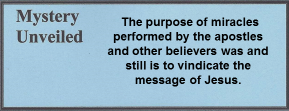
“Born again.” This could also be translated as, begotten from above.[10] When referred to from the father’s side, the verb is “beget.” When referred to from the mother’s side, the verb is “bear.” In this context, the phrase means to be “begotten of water and the Spirit of God” and it affirms a heavenly origin.[11] As for Nicodemus, he knew that the term was applied to those who converted to Judaism.[12] His problem was that the meaning had been lost in the prevailing externalism of observing the Oral Laws that was the heart and soul of Pharisaic doctrines.
For the Jewish people to learn that they had to be “born again” was totally contrary to their basic beliefs.[13] Since they were God’s chosen people, they believed all of Abraham’s descendants were, therefore, saved.[14] They believed that only pagans and unbelievers needed to be born again.
Clearly the concept behind the phrase was not new, but had to be reapplied to everyone. In the minds of many Jewish people, all Gentiles were damned to hell. Righteous Jews believed that Gentiles who observed the Noahide Commandments would have a place in heaven someday. Therefore, when a Gentile converted to Judaism, he was “born again” because now his destiny was changed – he became a member of God’s “Chosen People” and was destined to enjoy eternal life. [15] The last thing that Nicodemus ever thought he needed, with all his credentials, was to be born again.
The advantage for the believer of being “born again” or receiving “birth from above” is that he becomes a partaker of the new covenant with God. This includes all of the privileges and responsibilities of being a child of God, including the right to address the God of the universe as “Father.” The responsibility requires that one maintain a biblical relationship with the Father as well as with the brothers and sisters in the church. The intimate and devoted relationship of a husband and wife is representative of the devotion God the Father desires to have with all His children. To become born again is not only a one-time decision, but the beginning of a new relationship with God.
Jesus came to earth so man might be saved from his sins. Salvation is found only by complete faith in and dependence on Jesus Christ. It is because of Him that we have complete redemption and forgiveness of sins. Jesus, who lived a sinless life, died for the sins of humanity, and returned to life from the grave on the third day.[16] It is the responsibility of men to accept the gift of salvation and, thereby, receive eternal life. The decision to become a disciple of Jesus was followed by a public confession at the time of baptism. In this ceremonial process the new converts in the first century church were baptized either “in the name of Jesus” (Acts 2:38; 10:48) or “into the name of Jesus” (Acts 8:16; 19:5). Either way, the rite was a confession of faith (Rom. 10:9-10), an offer to accept forgiveness of sin (Acts 2:38; 12:16), to accept the gift of the Holy Spirit (Acts 2:38; 10:44-48), and a commitment to be obedient to His word.[17] This was a doctrine of the early Christian faith.[18]
John 3:16 in the King James version “For God so loved the world, that he gave his only begotten Son, that whosoever believeth in him should not perish, but have everlasting life” is without question the most quoted verse in the New Testament. It reveals the following:
- God loves His people
- To love is to give, great love requires a great gift and God loves humanity so much that He gave what was most precious to Him – His son.
- Jesus knew that He was the Son of God.
- Jesus was aware that He would die a sacrificial death for all humanity – past, present, and future.
- Mankind without faith in Christ Jesus is doomed to destruction; mankind with faith in Christ Jesus will receive eternal life.
- Faith and trust in Jesus is not an intellectual acknowledgement, but a personal relationship.
05.05.05.Q1 Why does John 3:16 say that God loves the world and John 9:39 says that Jesus came to this world to judge it?
John 3:16 is the famous verse that says that God loved the world so much that He gave His only Son Jesus that anyone who believes in Him will never perish but have ever lasting life. Yet John 9:39 says that Jesus came into this world to judge it. Obviously the second verse doesn’t sound very loving.
Jesus did indeed come to bring salvation to the world. He does, in fact, love everyone and, as St. Augustine once said, “Jesus died for every one of us as if there was only one of us.” However, not everyone accepts the free gift of salvation. For those who reject His calling the Day of Judgment will be most unpleasant. So both John 3:16 and 9:39 are true; 3:16 is offered first and, if rejected, 9:39 goes into effect. As someone else once said, “decisions determine destiny.”
“Unless someone is born of water and the Spirit, he cannot enter the kingdom of God.” There can be little question that Jesus referred to Ezekiel’s prophecy (36:25-27; Dead Sea Scroll 1QS 4:20-22).[19] Rabbi Shim’on Ben-Lakish once said that a “Proselyte is like a newborn infant”[20] to which Rabbi Yosi agreed.[21] Yet those trapped by preconceived ideas of a political-messiah did not recognize it. The two key terms “born of water” and born of spirit are explained below.
- The term “born of water” on line “A” as found in rabbinic writings and in this context, means natural birth, as a child in the womb is in its water sac.[22] This meaning is further clarified on line “A’” with the term is “born of the flesh is flesh.” The connection is obvious – what is born of water is born of flesh, and this is clarified when read in its poetic format.
Christians have associated the phrase, “born of water,” with baptism practiced by a new convert to the Christian faith. Just as the Israelites escaped the bondage of Egypt, they walked through the Red Sea,[23] and went forth to enjoy the new life in the Promised Land. Likewise, baptism symbolizes death to the bondage of sin. Being immersed in baptism is symbolic of the Israelites passing through the Red Sea and rising out of water is symbolic of the promised new life in Christ. Jesus introduced a new use for it.
Baptism was well established among the Essenes. According to Dead Sea Scroll 4Q414, one of the requirements to become a member of the Qumran sect was to be baptized. While the scroll fragment was found tattered with some pieces missing, sufficient script was found to recreate the original document.
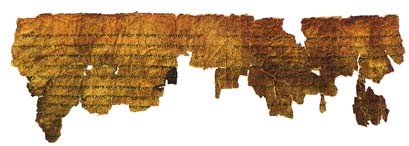
05.05.05.A. DEAD SEA SCROLL 4Q414 WITH BAPTISMAL LITURGY. Dead Sea Scroll 4Q414 preserved the baptismal liturgy for the Essene sect who lived in various communities, most notable in Qumran. Baptism was part of the acceptance ritual for new membership into the group. Photograph by Wikipedia Commons.
Notice that the first section requires a response; this differs from a mikvah immersion for purity which one did by oneself. An Essene baptism always required a minimum of two people. The scroll fragments from cave 4 read as follows:
(…And he shall) say (in response) “Blessed (are You,) the unclean for the festivals of (…) Your (…) and to make atonement for us (…to be) pure before you (…) in every matter (…) to purify oneself prior to (…) You made us (….).”
F.2 Col.1
And you shall cleanse him for Your holy statutes (..) for the first, the third and the sixth (…) in the truth of Your covenant (…) to cleanse oneself from uncleanness (…) and then he shall enter the water (…) And he shall say in response “Blessed are You (…) for from what comes out of Your mouth (…) men of impurity (…) .
F.2 + 3. Col.2
Soul (…) he is (…) to Yourself as a pure people [24] (…) And I also (…) the day which (…) in the times of purity (…) the Yahad. In Israel’s pure food (…) and they shall dwell (…). And it will happen on that day (…) a female and she will give thanks (…)
F.10
For You made me (…) Your will is that we cleanse ourselves before (…) and he established for himself a statute of atonement (…) and to be in righteous purity and he shall bathe in water and sprinkle upon (…) (…) And then they return from the water (…) cleansing His people in the waters of bathing (…) second time upon his station. And he shall say in response: “Blessed are You (…) (…) Your purification in Your glory (…) (…) eternally. And today (…).
F.12
Dead Sea Scroll Fragment, 4Q414 with Baptismal Liturgy[25]
According to Jesus, the baptism ritual symbolized a new phase of life and commitment to God to carry out that calling. Water for drinking is symbolic of the Holy Spirit whereas water for washing is symbolic of the Word of God for cleansing. Jesus spoke of the Spirit in the form of “living water,” as in His discussion with the Samaritan woman (Jn. 4). When the water was poured over the brazen altar at the morning sacrifice, it was to remember the water that flowed from the rock that Moses struck (Ex. 17; 1 Cor. 10:4). Baptism was not only a physical immersion in water, but that same water was symbolic of being immersed in the Holy Spirit.
The dispensation of the Spirit could not begin until the work of Jesus as redeemer was finished. There could be no Pentecost until there was first a Calvary. Only after Jesus was exalted in heaven did the Spirit celebrate the coronation. Only after the Rock (Jesus) was smitten, could the rivers of water (Holy Spirit) flow. The extent of that flow is dependent, in part, to how we thirst, drink, and believe in the glorified Jesus Christ. Jesus said, “If any man thirst” (Jn. 7:37) and Jesus continued to speak of the Holy Spirit. Nothing could stop Calvary and nothing could stop Pentecost; the “living water” of Jesus.
The process of being born again or born from above includes a ritual called baptism. The term is from the Greek word baptismos or baptisma. It’s root word bapto means to dip and as such was used by the Greek poet Homer to describe the dipping of steel in water to temper it.[26] The Hebrew counterpart is tabhal, and is often translated simply as to dip, as when Naaman dipped himself in the Jordan River (2 Kgs. 5:14).[27] It was not a new phrase and people were familiar with the word.
- “Born of the Spirit.” The regeneration of life in the new believer is the key. This is of a spiritual nature and, with it there is the immediate divine promise of eternal life, as well as divine strength to pass through the difficulties of this life. While this is of a spiritual nature, the physical challenges, such as addictions, often remain to be healed in a slower process. However, by the power and grace of Jesus Christ, the new believer can break free of these bondages.
The Jews practiced baptism for the conversion of Gentiles. Hence, it was not a new institution for them. It had been a ceremonial ritual, but did not have the same concept of repentance as taught by John the Baptist and Jesus. The Essenes, on the other hand, were probably more on target in understanding this concept than most believers today realize. They had a daily ritual immersion bath for purification that included a confession of sins. It is interesting that they said such a ritual immersion was worthless without a repentant heart. This doctrine developed in the previous two centuries and the entire Jewish nation was aware of it. Therefore, when Jesus preached it, His message was not entirely new. The Essenes appear to have had clear understanding of the times in which they lived that would usher in the messiah – and interesting reflection upon the “fullness of time” in Galatians 4:4, which had not yet been written by the Apostle Paul.
Finally, the initial difference between the lost and the saved is not who is guilty and who is innocent, but rather how each person responds to the gospel message. Nicodemus knew that righteousness was required to enter the kingdom of the Messiah (Ps. 24:3-4) and he knew the details of the Law. He was about to learn that the Law was a reflection of what the condition of the heart ought to be.
Whereas the Written Law directs the behavior of man toward God from an external source, a change of heart, the Kingdom of God directs the behavior of man toward God from an internal source. The concept of the Messiah as the Savior of humanity and the indwelling of the Holy Spirit in the life of the believer were not in first century Jewish expectations.
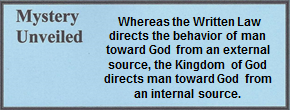
Jesus said to him. “Are you a teacher of Israel?” In the Greek, a definite article indicates Nicodemus was one of the most respected educators of his time and it would read, “Are you the teacher?” meaning, “senior theologian,” or, “professor,” in Israel ….”[28] Jesus was not indicating any lack of knowledge of the Law, but He was critical of Nicodemus’ inability to understand what He was teaching. Nicodemus had been so strongly instructed in every facet of the Law that he failed to understand its purpose. For this reason, Jesus gave the illustration of Moses in Numbers 21:8-9.
“Our testimony.” When the New Testament writers used terms such as “testimony,” “bore witness” or “I have seen and testify,” these are statements of legal terminology. These statements were common in Roman, Greek, and Jewish cultures whereby the author placed himself under an oath concerning the truthfulness of the statement made.[29]
05.05.05.Q2 How could an evil symbol of a snake of Numbers 21:4-9, be associated with Jesus crucified upon a Cross?
The passage in John 3:14 reads “Just as Moses lifted up the snake in the wilderness (desert)” and with it Jesus reflected upon an Old Testament story in Numbers 21:4-9. In that account the people of Israel journeyed through the desert and complained bitterly and regretted that they had ever left Egypt. God punished them for complaining and murmuring, and, after receiving some nasty snake bites, they repented and cried for mercy. God told Moses to make a brass snake, place it on top of a pole, and when the people looked upon it they would be healed. Years later during the days of Hezekiah, the brazen serpent became an idol (2 Kgs. 18:4). The irony was that they were not to make a graven image of any living thing, yet when they looked upon a brass snake, they were healed.
The wilderness event is sometimes problematic for modern students, because the snake is associated with the demonic serpent of Genesis. How could such an evil symbol be associated with Jesus who would be lifted upon a cross? This is the perfect example of how two cultural perceptions, separated by centuries, leads to perplexing conclusions.
From the days of Moses through to the first century, many believed that because a snake sheds its skin every year, it was a symbol of renewed life.[30] When the ancient Israelites looked upon the snake on top of the pole, they looked upon renewed life. Today, when we look upon Jesus on the cross, we look upon renewed life. In the Old Testament Period, it was certainly not the snake that healed, nor was it Moses, but it was God. Centuries later it was Jesus who healed. Ironically, among the Greeks and Romans the symbolic snake appeared with ancient gods and goddesses of healing as well as in pagan accounts of virgin births.
There are two issues taking place in this passage that challenge the modern reader.
- The symbolic issue of the snake, and
- The phrase “just as Moses lifted up the snake in the wilderness,” which must not be disconnected from the statement, “the Son of Man must be lifted up.” John 3:14 places Jesus as One who was more holy than Moses, and verse 15 states that all those who believe in Him (Jesus) have eternal life. By this Jesus clearly declared His equality with God, and that was a dilemma they could not accept.
“The Son of Man must be lifted up.” The early church recognized these interpretations to this comment:
- The literal “lifted up” event when Jesus was hung on the cross.[31]
- The literal “lifted up” when He arose from death and walked out of the grave.
- The literal “lifted up” of the ascension
- The early church understood this phrase as a literal fulfillment of Isaiah’s prophecy:
See, My Servant will act wisely;
He will be raised and lifted up and greatly exalted.
Isaiah 52:13
- The early church recognized the divinity of Christ Jesus. He had thrown a new light on the Scriptures; He revealed God in a new aspect – as no mere national deity, but as the Father of all mankind. He also taught the most enlightening concepts of freedom of the individual conscience.
“World.” John places a unique emphasis on this word by repeating it three times – a Jewish custom of giving something the maximum level of importance. Furthermore, he used the Greek word kosmos, meaning a sinful place where Satan rules.[32] The word is repeated twice in verse 17 and again in verse 19. His message is that Jesus came into this world to save sinners.[33]
Jesus then closed the meeting by saying that men love the cover of darkness to cover their sins. This was not intended to be an insult or degrading, but simply to underscore the need for regeneration of life (being born again).
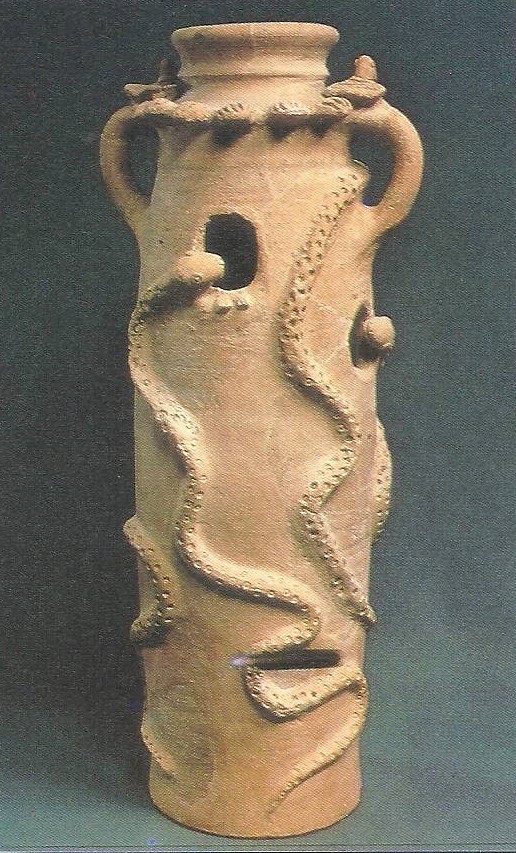
05.05.05.B. EARLY ISRAELITE INCENSE BURNER ADORNED WITH SNAKES. Incense burner adorned with snakes of the earlier Israelite Period. Snakes represented renewed life throughout the biblical period. Photograph courtesy of the Israel Museum.
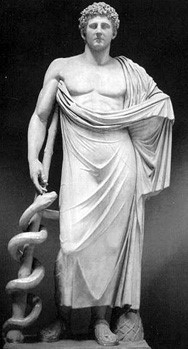
05.05.05.C. THE GREEK GOD ASCLEPIUS WITH STAFF AND SNAKE. The statue of the god Asclepius is always shown with a staff entwined with a snake, and as such was known as the “rod of healing.”[34] The snake was not symbolic of any demonic spirit, but of new life because it sheds its skin yearly. Photo by Wikipedia Commons
05.05.05.Q3 Should Nicodemus have known or suspected anything about a “new birth” (Jn. 3:1-21)?
Absolutely, yes! He was aware of the baptismal rites within Judaism and, therefore, should have made a connection with what Jesus was telling him. He also should have been aware of King David’s two horrific sins for which there was no atonement: murder and adultery. As a result he cried out unto the Lord and said,
10 Create in me a pure heart, O God, and renew a steadfast spirit within me.
11 Do not cast me from your presence or take your Holy Spirit from me.
12 Restore to me the joy of your salvation and grant me a willing spirit to sustain me.
Psalm 51:10-12 (NIV 1984)
What David requested from our Lord was a regeneration or new birth, for he realized that cleansing himself was a vain exercise (Ps. 73:13). The Essenes, even though they lived under the Old Covenant, realized that the Holy Spirit purifies the heart. They even spoke freely of God’s Spirit of holiness as a cleansing and purifying power as revealed in a number of Dead Sea Scrolls.[35] Notice the similarities between Dead Sea Scroll 1QS 4.21,[36] written about a century before Jesus was born,[37] and Matthew 3:11 and Luke 3:16 as illustrated below.
He shall cleanse him of all wicked deeds with the spirit of holiness; like purifying waters He will shed upon him the spirit of truth (to cleanse him) of all abomination and injustice.
Dead Sea Scroll 1QS 4.21[38]
“I baptize you with water for repentance, but the One who is coming after me is more powerful than I. I am not worthy to remove His sandals. He Himself will baptize you with the Holy Spirit and fire.
Matthew 3:11
John answered them all, “I baptize you with water, but One is coming who is more powerful than I. I am not worthy to untie the strap of His sandals. He will baptize you with the Holy Spirit and fire.
Luke 3:16
Nicodemus, as the head of a seminary, should have known that the Messiah would be Israel’s refiner and purifier as stated in passages such as Malachi 3:1-3. That purifying had already begun with the temple cleansing, but he did not recognize it. Yet the Spirit moved his heart to discuss this with Jesus.
The rabbis, of which Nicodemus was one, had long connected the ritual of baptism (complete immersion in water), with washing as instructed in Exodus 19:10. It was deemed to be the first step in holy living and preparation to be in communion with God.[39] This opinion was summarized by Josephus concerning the ministry of John the Baptist. The background to this narrative is that Herod Antipas had executed John, and then entered into battle with the Nabateans who soundly defeated him. The Jewish community believed the defeat was divine judgment for a horrible sin against a righteous man. Note the comment on Jewish baptism:
Now, some of the Jews thought that the destruction of Herod’s army came from God, and that very justly, as a punishment of what he did against John, that was called the Baptist for Herod slew him who was a good man, and commanded the Jews to exercise virtue, both as righteousness towards one another, and piety towards God, and so to come to baptism. For that washing [with water] would be acceptable to him, if they made use of it not in order to the putting away [or the remission] of some sins [only], but for the purification of the body.
Josephus, Antiquities 18.5.2 (116-117b)[40]
As previously stated, baptism did not originate with Christianity, but with Judaism.[41] When a Gentile converted to Judaism, he was baptized. [42] When a disciple became a rabbi, he was baptized as part of his ordination service. Some sources indicate that when one became a member of the Sanhedrin, there was a baptism. Such rites were associated with the new responsibility and direction in life. The rite, along with “born again” terminology was common in Pharisaic writings. Therefore, Nicodemus should have known or at least made an educated guess at what Jesus was talking about. There were several times when a man could be “born again” according to Jewish theology and tradition.[43]
1. When a Gentile man converted to Judaism, he had to perform three things:[44]
- Be circumcised[45]
- Make an offering at the temple
- Be immersed in a mikvah; after this a man was considered a “new born child” and accepted in Jewish society.[46] That immersion was not a ritualistic immersion in a mikvah to cleanse defilement, but a baptism concerning the forgiveness of sins as John the Baptist did. Records show that some rabbis permitted baptism immediately after circumcision, while the School of Hillel said baptism should be seven days after the circumcision.[47]
- When a Gentile slave, either man or woman, became the property of a Jew, he/she had to be baptized.[48]
- When a Jewish man was crowned king
- At the time of his bar mitzvah (age 13 years and 1 day). From that day on he qualified to be one of ten men and women to begin a new synagogue.[49]
- When he married a wife (usually between ages 16 and 20).
- When a man was ordained as a rabbi (age 30)
- When a rabbi joined the Sanhedrin (age 50)[50]
However, some scholars believe that the “baptisms” of points 3 through 7 above were not baptisms, but purification rituals in a mikvah.[51] But regardless, Nicodemus should certainly have known what Jesus meant when He used the terms such as “born of water,” “born of the water,” or “baptize.”[52] No wonder that Jesus said, “Are you the teacher…”[53] Therefore, “the teacher,” who in all probability was the head of a seminary, had a small following of disciples, and as a member of the Sanhedrin he should have understood what Jesus meant.[54] Furthermore, the Apostle Paul made an interesting comment on baptism in his first letter to the Corinthian church when he said “All under the cloud, and all passed through the sea, and all were baptized into Moses in the cloud and in the sea” (10:1b-2). Clearly, not only did the apostle know what baptism meant, but those in his audience understood that their forefathers understood the term as well.
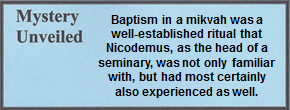
One scholar gather a number of writings and composed a comparison of early Christian baptism ritual of conversion to Jewish baptism and ritual of conversion. [55] Notice the striking similarities.
Christian Baptism Jewish Proselyte Baptism
Candidates are asked about their Candidates are asked about their
motive for conversion.[56] motive for conversion.[57]
Candidates must have witnesses who Candidates must have two or three
can guarantee the sincerity of witnesses at baptism.[58]
of the candidates.[59]
Requirement of pre-baptismal instruction Instruction in some of the heavier in ethical catechism. and some[60]of the lighter commandments of the law.[61]
Immediately before baptism: Exorcisms, Proselyte Aseneth praying and fasting.[62]
Prayer and fasting.[63]
The candidates must renounce the Devil and Aseneth renounces the Devil and idols.[64]
Reject idol worship.[65]
Baptism to be in “living [running] water” Baptism in flowing water on in a mikvah.[66]
but also poured from a basin.[67]
Water to touch every part of the candidate’s Water to touch every part of the candidate’s body; women to loosen hair body; women to loosen hair and remove and remove jewelry; no alien object on the body.[68]
jewelry; no alien object between the water and
the body.[69]
After baptism, candidate brings bread After baptism, the candidate participates in
and wine as an offering to the first first Passover meal with offering.[70]
Communion.[71]
While this is not a comprehensive list, there are enough similarities. Finally, the concept of rebirth or born again was well known to both Jews and Gentiles. For the Jewish people, the concept is discussed above. For the Gentiles, the Romans and Greeks were familiar with the phrase because it was in nearly all of the ancient mystery religions.
05.05.05.Q4 In light of Romans 10:9, was it possible for Nicodemus to become born again?
Yes, if the answer were limited to this passage in Romans, which states that eternal life is obtained if first, one confesses that Jesus is Lord, and second, one believes that God raised Him from the grave. The problem is obviously that Jesus was very much alive when He spoke to Nicodemus.
The New Testament was written years after the ministry of Jesus. While being “born again” is generally and accurately defined by Romans 10:9, a passage that is more applicable pertains to the new creation Jesus spoke of and is found in 2 Corinthians 5:17. It states that “if anyone is in Christ he is a new creation.” That was precisely the point Jesus made. Nicodemus needed to become a new creation in Christ, which today is known as becoming “born again.”[72]
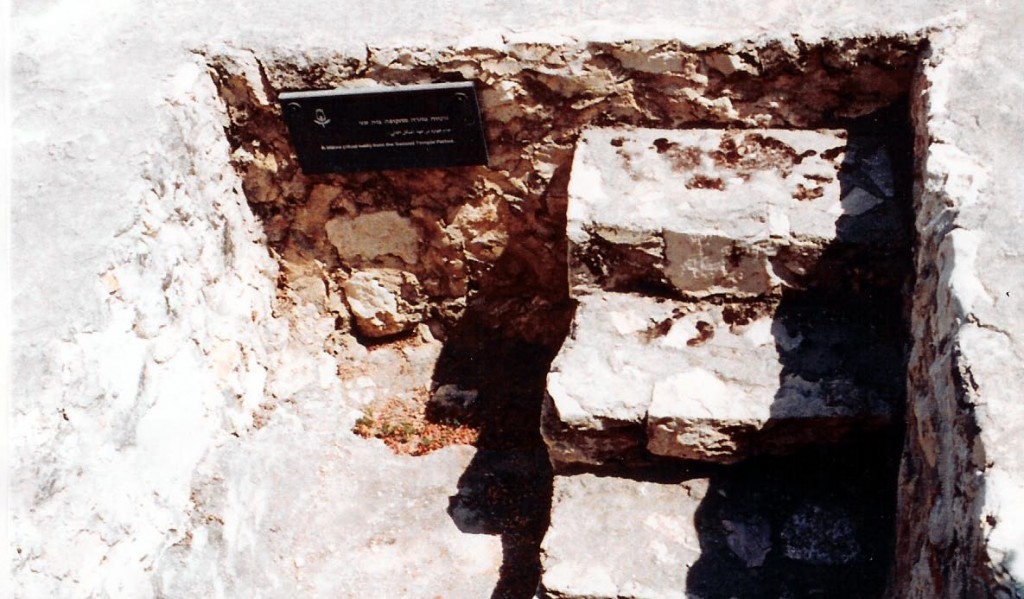
05.05.05.D. FIRST CENTURY MIKVAH. A mikvah like this one, located at the southern steps of the temple, became the pattern for baptismal fonts used by the church. Photograph by the author.
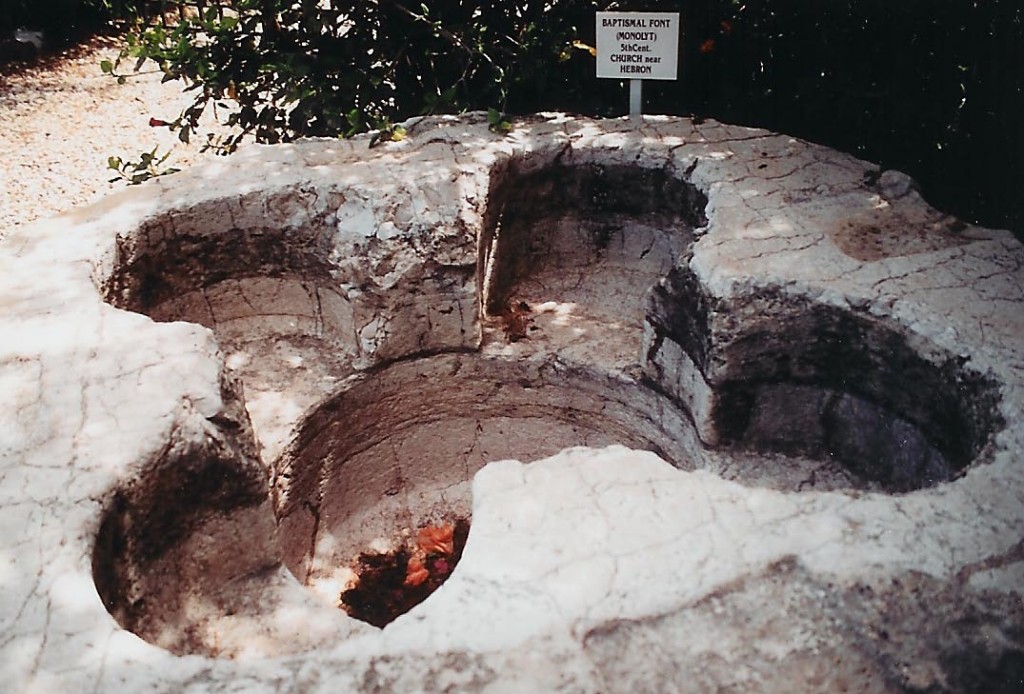
05.05.05.E. FIFTH CENTURY CROSS-SHAPED BAPTISTRY. The concept of a step-down baptistery was patterned after the Jewish ritual mikvah. The Jewish rite was adapted by the early church when a river or body of water was not available. This cross-shaped baptistery is located along the northern edge of the Sea of Galilee. Photograph by the author.
[1]. Cited by Jeremias, Jerusalem in the Time of Jesus. 96 n 27.
[2]. Fruchtenbaum, The Jewish Foundation of the Life of Messiah: Instructor’s Manual. Class 6, page 11; Lightfoot, A Commentary on the New Testament from the Talmud and Hebraica. 3:261-63; Jeremias, Jerusalem in the Time of Jesus. 226, 228-29.
[3]. For more information, read the Inter-Testamental history from Antiochus IV Epiphanes in 176-164 B.C. (03.04.17) to the death of Herod the Great in 4 B.C. (03.06.04).
[4]. Geikie, The Life and Words. 1:547.
[5]. Pentecost, The Words and Works of Jesus Christ. 122-23.
[6]. Farrar, The Life of Christ. 106-08.
[7]. Lawrence, The Seven Laws of the Harvest. 37.
[8]. Geikie, The Life and Words. 1:549; Packer, Tenney, and White, eds., The Bible Almanac. 557.
[9]. Packer, Tenney, and White, eds., The Bible Almanac. 557.
[10]. Vine, “Only Begotten.” Vine’s Complete Expository Dictionary. 2:447-48.
[11]. Howard, “St. John: Introduction and Exegesis.” 8:505; Farrar, Life of Christ. 93; Fruchtenbaum, Life of the Messiah. Tape 4, side A.
[12]. Geikie, The Life and Words. 1:505.
[13]. For further study see Allison Jr., “One Baptism of Jesus and a New Dead Sea Scroll.” 58-60; See also “A Messianic Vision.” Biblical Archaeology Review. 17:6 (Nov./Dec, 1991) 65.
[14]. Tenney, “John.” 9:48. xx.
[15]. Lightfoot, A Commentary on the New Testament from the Talmud and Hebraica. 3:265-68.
[16]. Jesus died on a Friday afternoon and arose on Sunday morning. The Hebrew method of counting time is that the day ends at sundown. Any time prior to sundown was counted as a full day. Any portion after sundown was also considered a full day. Hence, Jesus was considered dead for three full days.
[17]. For an example of a first century baptismal rite, see 18.02.04.
[18]. For other references to the salvation of man, see Jn. 3:16-17, 10:9-10; Lk. 19:10; Heb. 12:2; Acts 4:12; Eph. 1:17, 2:8; Rom. 8:16. For the fall and redemption of humanity, see Gen. 1:26, 31; 3:1-7; Ps. 8:4-8; Rom. 5:12-21; 1 Cor. 15:21-22; 2 Cor. 5:17. The fall and redemption of humanity and, his salvation by the death and resurrection of Christ Jesus are two critical doctrines of the Christian church. See also Ralph Martin, Worship in the Early Church. 61, 89, 99.
[19]. The Essenes seem to have had a basic concept that atonement could be gained by the Holy Spirit. For further study, investigate comments on Dead Sea Scroll 1QS 3:6b-8, 1QS 4:20-22, and related fragments.
[20]. Babylonian Talmud. Yevamot 62a.
[21]. Babylonian Talmud, Yevamot 48b.
[22]. Fruchtenbaum, The Jewish Foundation of the Life of Messiah: Instructor’s Manual. Class 6, page 8.
[23]. Some ancient manuscripts refer to the Red Sea as the Reed Sea. Scholars believe it was because of the reeds that grew along the shoreline.
[24]. Purity was a major issue among orthodox Jews because of the continuous encroachment of Hellenism in Jewish families. Purity (Gk. katharos) was defined within the realm of physical, religious, and ethical purity; a term that has both figurative and literal requirements of behavior. See Link and Schattenmann. “Pure, Clean.” 3:102-03.
[25]. http://www.gnosis.org/library/baptl.htm Retrieved July 17, 2011; See also Martinez, The Dead Sea Scrolls. 439.
[26]. Homer. Odyssey. 9.392; See 05.02.03.
[27]. Williams, “Baptize, Baptism.” 27-30.
[28]. Howard, “St. John: Introduction and Exegesis.” 504-05; Farrar, Life of Christ. 93.
[29]. Bookman, When God Wore Sandals. CD Trac 5.
[30]. Negev, The Archaeological Encyclopedia of the Holy Land. 248. Notice that even some emperors like Alexander the Great, believed they were born of a virgin who became pregnant by the actions of a snake. See 04.03.08.Q7 “How does one explain other so-called virgin births in history?”
[31]. See comments by Messianic scholar Timothy Hegg on the term “lifted up” in 01.02.01.V.
[32]. Lang, Know the Words of Jesus. 209-10.
[33]. Compare Jn. 1:10 and 15:19.
[34]. Luz. “Ancient Medicine and Philosophy: Twin Professions.”15.
[35]. See Dead Sea Scroll: 1QS 3.7-9; 4.21; 1QH 16.12 cf 7.6; 17.26, Fragment 2.9, 13.
[36]. Dunn, Baptism in the Holy Spirit. 9-10.
[37]. This scroll is known as The Community Rule or The Manual of Discipline. It is one of the earliest scrolls written by the Essenes; Vermes, The Complete Dead Sea Scrolls in English. 97.
[38]. Translated and parenthesis by Geza Vermes; Vermes, The Complete Dead Sea Scrolls in English. 103.
[39]. Tenney, The Gospel of John. 49.
[40]. Bracketed inserts for clarification by Whiston, ed.
[41]. Fruchtenbaum, The New Birth. 20-23.
[42]. For further study of Jewish baptism, see Skarsaune. In the Shadow of the Temple. Ch. 18, 353-75.
[43]. These baptisms would have been similar to those of John the Baptist who stressed true repentance. For more information on Jewish baptisms, see William S.LaSor, “Discovering What Jewish Mikva’ot Can Tell Us About Christian Baptism.” 52-59. Fruchtenbaum, The Jewish Foundation of the Life of Messiah: Instructor’s Manual. Class 6, pages 7-9; See also Zondervan’s New International Version Archaeological Study Bible. 2005. 1562.
[44]. Also see comments below “After Jesus was baptized” in 05.02.03.Q1.
[45]. Those men who decided to forgo the circumcision ritual, but observed the Noahide Commandments, were known as “God-fearing” men. They were not “Jewish converts,” but still respected among the Jewish people. For more information on the Noahide Commandments, see Appendix 17.
[46]. Livingston, “Jesus on Purity, Baptism, and Jewish Ritual Baths.” 1-2.
[47]. Jeremias, Jerusalem in the Time of Jesus. 307; Geikie, The Life and Works of Christ. 1:396.
[48]. Jeremias, Jerusalem in the Time of Jesus. 348.
[49]. The rabbinic rule that a minimum of ten men could establish a new synagogue was not established until centuries after Christ, around the time the Babylonian Talmud was written. For further study on the various opinions concerning the status and influence of women in the Second Temple Period, see the excellent work by Tal Ilan, Integrating Women into Second Temple History, Peabody, MA: Hendrickson, 1999.
[50]. Fruchtenbaum, Life of the Messiah. Tape 4, Side A.
[51]. See “Baptism” and “Mikvah” in Appendix 26.
[52]. According to Scott, Jr. Jewish Backgrounds of the New Testament. 146, one of the earliest scholars to research Jewish baptisms was a French scholar, Joseph Thomas, who authored Le Mouvement baptist en Palestine et Syrie (Gembloux: J. Duculot, 1935).
[53]. Emphasis by the author, but it is also in the Greek text.
[54]. Fruchtenbaum, The New Birth. 20-23.
[55]. Skarsaune. In the Shadow of the Temple. 359-60.
[56]. Apostolic Tradition 16.2.
[57]. Babylonian Talmud, Yevamot 47a.
[58]. Babylonian Talmud, Yevamot 46b.
[59]. Apostolic Tradition 16.2.
[60]. Didache 1-5; Justin, First Apology 61; Apostolic Tradition 16-17.
[61]. Babylonian Talmud, Yevamot 47a.
[62]. Joseph and Aseneth 10-13.
[63]. Didache 7; Justin, First Apology 61; Apostolic Tradition 20.3-10.
.
[64]. Joseph and Aseneth 10.8-13; 12.9-12.
[65]. Apostolic Tradition 21.9..
[66]. Sibylline Oracles 4:162-70..
[67]. Didache 7.
[68]. Apostolic Tradition 21.5.
[69]. Babylonian Talmud, Bava Qamma 82a/b.
[70]. Mishnah, Pesahim 8:8; Keritot 2:1.
[71]. Justin, First Apology 65; Apostolic Tradition 20:10; 23:1.
[72]. Fruchtenbaum, The New Birth. 40-43.